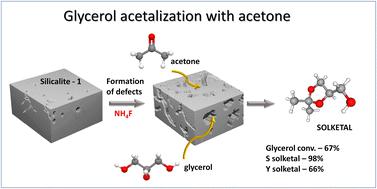当前位置:
X-MOL 学术
›
Dalton Trans.
›
论文详情
Our official English website, www.x-mol.net, welcomes your
feedback! (Note: you will need to create a separate account there.)
Enhancing the catalytic properties of silicalite-1 through ammonium fluoride modification for waste glycerol acetalization
Dalton Transactions ( IF 3.5 ) Pub Date : 2024-07-24 , DOI: 10.1039/d4dt01523a Jolanta Kowalska-Kuś 1 , Ewa Janiszewska 1 , Kinga Góra-Marek 2 , Aldona Jankowska 1 , Agnieszka Held 1
Dalton Transactions ( IF 3.5 ) Pub Date : 2024-07-24 , DOI: 10.1039/d4dt01523a Jolanta Kowalska-Kuś 1 , Ewa Janiszewska 1 , Kinga Góra-Marek 2 , Aldona Jankowska 1 , Agnieszka Held 1
Affiliation

|
Silicalite-1 is a silica with a zeolitic MFI (Mobil Five) structure devoid of noticeable catalytically active (e.g., acid) sites. In this study, we present its modification with NH4F solutions of varying concentrations (0.5–3 M), which generates efficient and selective acid sites for the acetalization of glycerol with acetone towards solketal (2,2-dimethyl-1,3-dioxolane-4-methanol). The creation of acid sites is attributed to the partial elimination of external silanol groups in silicalite-1 and the generation of some framework defects, resulting also in increased porosity. The characterization of the modified materials was performed using various techniques, i.e. X-ray diffraction (XRD), scanning electron microscopy (SEM), transmission electron microscopy (TEM), temperature-programmed desorption of ammonia (TPD-NH3), and Fourier-transform infrared spectroscopy (FTIR). The results demonstrate that the newly created acidic sites of Brønsted and Lewis nature exhibit significantly higher acidic strength and enhanced accessibility for reagents compared to the pristine one, resulting in exceptional glycerol conversion in the acetalization of glycerol with acetone and notable selectivity towards solketal. Glycerol conversion over modified silicalite-1 reached nearly 70%, with the selectivity to solketal exceeding 98% at 70° C after 1 hour of reaction time, using a mixture of glycerol and acetone in a 1 : 1 ratio. The proposed reaction mechanism takes into account a combination of Brønsted and Lewis acid sites. The obtained results indicated that Brønsted acid sites, especially those of higher strength, are the most beneficial in this process. The remarkable catalytic performance and stability of modified silicalite-1 make it a promising candidate for potential industrial applications in the utilization of waste glycerol formed in the biofuel industry.
中文翻译:

通过氟化铵改性增强Silicalite-1对废甘油缩醛化的催化性能
Silicalite-1是一种具有沸石MFI(美孚五号)结构的二氧化硅,缺乏明显的催化活性(例如酸)位点。在本研究中,我们提出了用不同浓度(0.5-3 M)的 NH 4 F 溶液对其进行修饰,生成有效且选择性的酸位点,用于将甘油与丙酮缩醛化为 solketal(2,2-二甲基-1,3-)二氧戊环-4-甲醇)。酸性位点的产生归因于silicalite-1中外部硅烷醇基团的部分消除以及一些骨架缺陷的产生,从而导致孔隙率增加。使用各种技术对改性材料进行表征,即X 射线衍射 (XRD)、扫描电子显微镜 (SEM)、透射电子显微镜 (TEM)、氨程序升温解吸 (TPD-NH 3 ) 和傅立叶分析-变换红外光谱(FTIR)。结果表明,与原始酸性位点相比,新创建的布朗斯台德和路易斯性质的酸性位点表现出显着更高的酸性强度和增强的试剂可及性,从而导致甘油与丙酮的缩醛化反应中甘油转化率异常高,并且对丙酮缩醛具有显着的选择性。使用甘油和丙酮以 1:1 的比例混合时,改性硅沸石-1 上的甘油转化率达到近 70%,在 70°C 反应 1 小时后,对丙酮醇的选择性超过 98%。所提出的反应机理考虑了布朗斯台德酸位点和路易斯酸位点的组合。所得结果表明,布朗斯台德酸位点,尤其是那些强度较高的酸位点,在此过程中是最有利的。 改性硅沸石-1 卓越的催化性能和稳定性使其成为生物燃料工业中形成的废甘油利用的潜在工业应用的有希望的候选者。
更新日期:2024-07-29
中文翻译:

通过氟化铵改性增强Silicalite-1对废甘油缩醛化的催化性能
Silicalite-1是一种具有沸石MFI(美孚五号)结构的二氧化硅,缺乏明显的催化活性(例如酸)位点。在本研究中,我们提出了用不同浓度(0.5-3 M)的 NH 4 F 溶液对其进行修饰,生成有效且选择性的酸位点,用于将甘油与丙酮缩醛化为 solketal(2,2-二甲基-1,3-)二氧戊环-4-甲醇)。酸性位点的产生归因于silicalite-1中外部硅烷醇基团的部分消除以及一些骨架缺陷的产生,从而导致孔隙率增加。使用各种技术对改性材料进行表征,即X 射线衍射 (XRD)、扫描电子显微镜 (SEM)、透射电子显微镜 (TEM)、氨程序升温解吸 (TPD-NH 3 ) 和傅立叶分析-变换红外光谱(FTIR)。结果表明,与原始酸性位点相比,新创建的布朗斯台德和路易斯性质的酸性位点表现出显着更高的酸性强度和增强的试剂可及性,从而导致甘油与丙酮的缩醛化反应中甘油转化率异常高,并且对丙酮缩醛具有显着的选择性。使用甘油和丙酮以 1:1 的比例混合时,改性硅沸石-1 上的甘油转化率达到近 70%,在 70°C 反应 1 小时后,对丙酮醇的选择性超过 98%。所提出的反应机理考虑了布朗斯台德酸位点和路易斯酸位点的组合。所得结果表明,布朗斯台德酸位点,尤其是那些强度较高的酸位点,在此过程中是最有利的。 改性硅沸石-1 卓越的催化性能和稳定性使其成为生物燃料工业中形成的废甘油利用的潜在工业应用的有希望的候选者。

















































 京公网安备 11010802027423号
京公网安备 11010802027423号